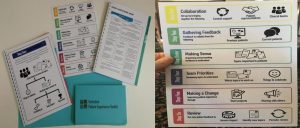The scoping review found 38 different types of feedback which can be divided into four categories. These are: hospital initiated quantitative surveys, patient initiated qualitative feedback, feedback and improvement frameworks and other sources. Whilst there are many different types of patient experience feedback available to use with UK hospitals, there are few which can be easily use for the purpose of quality improvement.
The findings of the qualitative study showed that the effective use of patient experience feedback is hindered at both the micro level (of how individual clinicians and teams of staff have difficulty engaging with the data sources) and the macro level (how organisational structures are unwittingly preventing progress). This is played out through various means in a macro sense such as: a lack of pan organisational learning, the intense focus on the collection of data at the expense of understanding how it could be used and fractured patient experience teams who want to assist ward staff but find this difficult. In a micro sense, a large amount of generic positive feedback is seen as unhelpful with ward staff struggling to interpret various formats of feedback whilst they question the value of it due to factors such as the timeliness and validity of the data.
The findings of the co-design process were iterative between the three workshops, with the findings from the first workshop being taken forward into the second and then the findings from the second being used to structure the third. Three themes emerged from the second workshop: forms of data and their uses, people and relationships, environments. These themes were then worked into a set of core principles that were used to structure the prototype of the toolkit. The design team reflected on the process of the participants working through the first prototype (in the third workshop) in order to develop PET for use during the action research testing phase. PET was then periodically refined during the 12 months of testing in reaction to what the action researchers were finding on the ground.
The testing and refinement of the PET during the action research phase, with the mixed methods evaluation running alongside, produced noteworthy findings. The idea that current patient experience data can be effectively triangulated for the purpose of improvement is largely a fallacy. Rather, additional but more relational feedback had to be collected by patient representatives, an unanticipated element of the study, in order to provide healthcare staff with data they could better work with. Multi-disciplinary involvement in patient experience initiatives is difficult to establish unless teams already work in this way. Regardless, there is merit in involving different levels of the nursing hierarchy. Consideration of patient feedback by healthcare staff can be an emotive process which may be initially difficult and needs dedicated time and sensitive management.
The six ward teams engaged variably with the action research process over a 12 month period. Some teams implemented far-reaching plans whilst other teams focused on time-minimising ‘quick wins’. The evaluation found that facilitation of the toolkit was central to its implementation. The most important factors here were the development of relationships between people and the facilitator’s ability to navigate organisational complexity.

